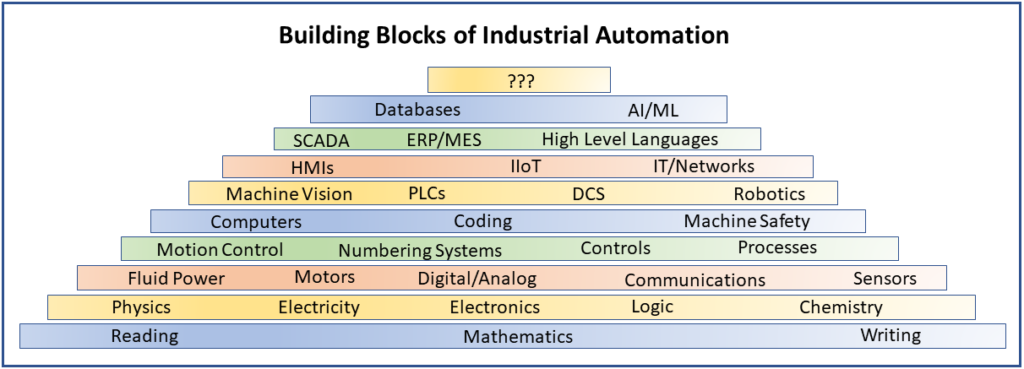Building Blocks of Industrial Automation

By the time we are ready to enter the workforce as an adult we have hopefully learned the fundamentals of reading, writing and mathematics, along with various social skills that help us get along with other people.
If we choose to enter a technical career field, there are additional topics that may be learned in school; physics, advanced math, and other sciences. In addition, there are skills that people may need to enter trades, such as welding, machining, wiring and other mechanical methods. These skills may rely on knowledge of some physics or advanced math also.
Skills certifications, technical schools and universities further prepare students to become journeymen or entry-level engineers in the workforce. Further development is often then left to on the job training and experience.
Training in some disciplines requires knowledge from other fields. This diagram illustrates some of the building blocks that are needed to progress in system integration skills in the field of industrial automation.
“PLC programming” is an example of a skill that many technicians and engineers want to learn without necessarily building on a stable base of knowledge. Most PLC classes concentrate on learning a particular brand’s hardware and instruction set, with the goal of being able to troubleshoot a machine or process. Students may be technicians or engineers and may have very different backgrounds and knowledge.
Commercial PLC classes usually include the following topics, specific to a brand or platform:
- Hardware overview
- Data and program structure
- Communications
- Programming exercises using the instruction set
- Troubleshooting tools including cross-reference, trending, program comparisons
Most of the typically 3-4 day-long classes consist of hands-on use of the software.
Though most students attend these commercial classes for the purpose of learning to troubleshoot, most of the troubleshooting exercises are on the last day. If a specific program is used for an exercise, it may be from a very different industry than the student is in.
Troubleshooting also requires knowledge of electrical and mechanical systems. Machine safety, motors, sensors, motion control and possibly robotics and machine vision may also be involved.
Using PLC software requires basic computer skills, digital and analog, communications, and some controls topics. Some older software also requires more extensive knowledge of numbering systems.
The term “PLC programming” is also often misapplied here. Use of the software to troubleshoot a system is more accurate, but since every machine or system is different this can be a difficult topic to cover without using the program for a specific machine.
Writing a program for a machine or process requires knowledge of many of the topics shown in the diagram at a higher level. Programming is a design function that requires experience on the specific software being used. Additional design skills using CAD or spreadsheets may be required, along with extensive experience with machinery.
The programmer of a PLC-controlled machine is also often required to program an HMI to interface with the PLC. Even if the PLC programmer is only responsible for the PLC code, they still need to understand the other systems that communicate with or are controlled by the PLC, such as VFDs, robots and cameras.
As machines and systems are interfaced with enterprise-level computers and servers, knowledge of databases, SCADA and enterprise-level software systems may be required. Cybersecurity, IT skills and high-level coding can be involved in integrating systems, and the technology involved is constantly evolving. Above all else, this requires integrators to be flexible and able to learn new platforms and technologies. These are among the most technical and complex projects a system integrator will be involved in.
As with any field of study, industrial automation and system integration requires specific skills that need to be mastered to progress to the next stage of learning. This is further complicated by the wide range of products, software brands and industries that may be involved. Some technicians and engineers spend their entire life in one industry working with a specific controls platform, or even on a specific type of machine. System integrators and custom machine builders need to be able to adapt to new platforms and technologies.
As can be seen in the “Building Blocks” diagram, engineers and technicians need to learn certain skills before attempting to understand more complex ones. Use this diagram to plan your own progression through your career!

0 Comments on “Building Blocks of Industrial Automation”